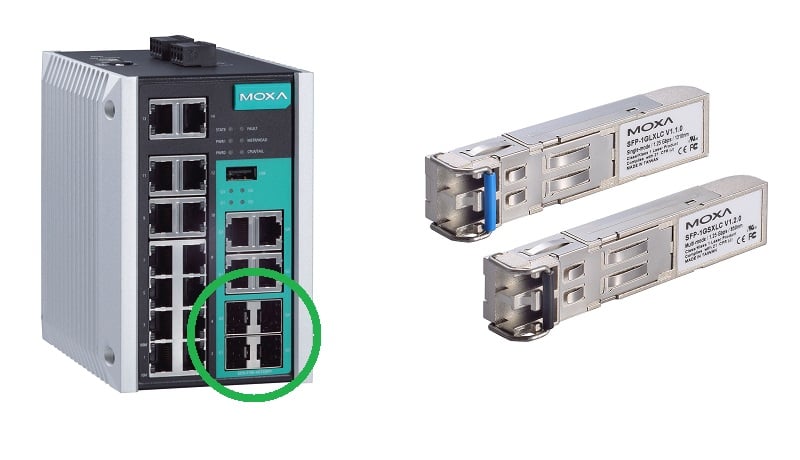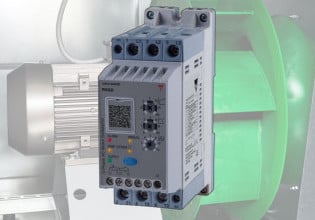Understanding Industrial Ethernet Connections: RJ45, Fiber, M12, and SFP
Ethernet switches can use four different types of connections: RJ45, fiber, M12, and SFP. Understanding the difference can help with network troubleshooting, design, or alteration.
Industrial Ethernet switches play a pivotal role in modern industrial networks, helping to facilitate reliable, high-speed communication between various devices and systems.
In this article, we will look at a variety of different Ethernet interface types: RJ45, fiber-optic, the common industrial M12 connection, and SFP, which stands for ‘small form-factor pluggable.’
Types of Industrial Ethernet Cables
The RJ45 port is one of the most common Ethernet setups and is compatible with copper cabling. It manages to provide simplicity for users in many installation circumstances. Fiber-optic connections have advantages in long-distance transmission and are immune to electromagnetic interference. M12 is a common industrial standard that makes a very durable, environment-proof connection for on-machine solutions. SFP ports are designed for modularity and versatility. This is possible because SFP ports allow users access to interchangeable transceivers that adapt to different networking requirements.
Understanding how Ethernet works and considerations of each connection type is useful for engineers and network administrators designing, deploying, and maintaining large industrial networks.
RJ45 Ethernet Interface
The Registered Jack, or RJ45, is a common physical interface for the connection of ethernet cables and is often used for large wired Ethernet networks. The RJ45 connector has eight connection pins and can be used for connecting devices to facilitate effective data communication.
Figure 1. A familiar RJ45 connector at the end of an Ethernet cable. Image provided by the Control.com engineering team
RJ45 Ethernet switch connections have long been the backbone of industrial networking infrastructure, providing reliable and versatile connectivity for various devices within a local area network (LAN). These connections utilize RJ45 connectors, which are standardized for Ethernet communication and compatible with twisted-pair copper cabling commonly used in industrial settings. RJ45 Ethernet ports offer simplicity and familiarity, allowing for easy integration with existing equipment and infrastructure.
With RJ45 connections, industrial Ethernet switches facilitate seamless communication between devices such as computers, PLCs, I/O and motion controllers, and actuators. This enables real-time data exchange and control for industrial automation systems.
Some RJ45 switch connections can usually support Power over Ethernet (PoE) technology, enabling the transmission of both data and power over the same Ethernet cable. This helps to simplify installation by reducing cable clutter and limiting expensive labor costs for installation.
Fiber Ethernet
Fiber Ethernet connections are known for their speed, reliability, and security. Utilizing fiber-optic cables, these connections transmit data with light signals rather than electrical signals.
Figure 2. The end of this fiber optic cable illustrates the light-carrying ability. Fiber used for Ethernet is smaller than this optical sensing cable. Image provided by the Control.com engineering team
Fiber Ethernet results in higher bandwidth capabilities and makes the system immune to electromagnetic interference or noise. Fiber-optic cables can span much longer distances than traditional copper cables (think tens of km, rather than hundreds of meters), making them ideal for connecting devices across large industrial facilities or harsh environments where signal degradation is often a concern.
They are also beneficial in processes that produce a lot of electrical noise, such as welding, or near electrical equipment. Fiber-optic cables are lightweight and flexible, allowing for easier installation and deployment compared to bulky copper cables. Additionally, fiber-optic cables can be routed through tight spaces or harsh environments where copper cables may be impractical or susceptible to damage.
Fiber Ethernet connections can provide enhanced security since they are more difficult to tap or intercept when compared to copper cables. Greater security can give users peace of mind for sensitive data transmissions in industrial settings.
On the downside, fiber Ethernet connections typically require specialized equipment and installation expertise. This is often offset with superior performance and robustness making them useful for critical applications in industrial automation, manufacturing, and control systems.
M12 Industrial Connector
For on-machine network solutions, regular connectors would not be appropriate. Not only are typical RJ45 and fiber connections fragile, they also allow tiny particles of dust and moisture to enter the switch. This may be just fine for control cabinets where you can protect the switch, but directly mounted on the machine demands something more robust.
Figure 3. An Ethernet cable with the familiar RJ45 at one end (center top) but a D-coded M12 at the other end (left). If you look carefully, you can see the missing pins on the RJ45 connector since the D-coded cables only have 4 conductors. Image provided by the Control.com engineering team
Threaded M12 connections, just like those found on many sensor and I/O modules, are used for these short-run, on-machine applications that transmit only data, providing an IP67 rating. A common application of these M12 Ethernet connectors is for IO-Link hubs and on-machine unmanaged switches. Some M12 Ethernet connectors have 4 pins (D-coded for Fast Ethernet), while others have 8 pins (X-coded for Gigabit speeds).
Small Form-Factor Pluggable (SFP)
SFP (Small Form-factor Pluggable) Ethernet connections consist of a small slot in a networking device capable of accepting an SFP module insert. Many modern networking devices have at least two SFP ports available to connect different switches via SFP modules and SFP-compatible cables.
SFP ports on Ethernet switches accommodate special transceivers, which are compact modules that enable the connection of fiber-optic cables, and sometimes copper cables. This modularity allows for easy adaptation to different networking requirements, whether it's extending network reach with fiber-optic connections or utilizing copper connections for shorter distances. SFP Ethernet connections provide flexibility for network administrators to mix and match transceivers based on their needs, without having to replace entire switches or buy multiple switches for each network type.

Figure 4. A variety of SFP switch ports (circled in green) and modules. Image (modified) used courtesy of Moxa
Additionally, SFP transceivers support various data rates, ranging from 1 Gbps to 10 Gbps or higher, enabling high-speed data transmission for bandwidth-intensive applications. The hot-swappable nature of SFP transceivers allows for convenient maintenance and upgrades without disrupting network operations. SFP modules are often designed to be compatible with a wide range of networking equipment from different vendors. This helps to ensure usability and makes for easy integration into most existing network infrastructures.
Currently, there are variations of SFP that support higher speeds and fiber densities, such as SFP+ and XFP, and it is likely that as technology evolves, there will be new variations which will eventually make their way into the world of industrial automation.
Choosing the Right Ethernet Connector
Understanding industrial Ethernet switch connections can be useful for better understanding how to design and implement new communications, in addition to maintaining older systems.
RJ45 ports offer simplicity and familiarity, fiber-optic connections are better suited for long-distance transmission, speed, and security, M12 for durable IP67 ratings, and SFP ports provide versatility and scalability. Each connection type presents unique advantages and considerations, shaping the reliability, performance, and adaptability of industrial networks crucial for modern manufacturing and automation processes. Understanding the strengths and weaknesses of each type of connection can lead to a better overall system.






